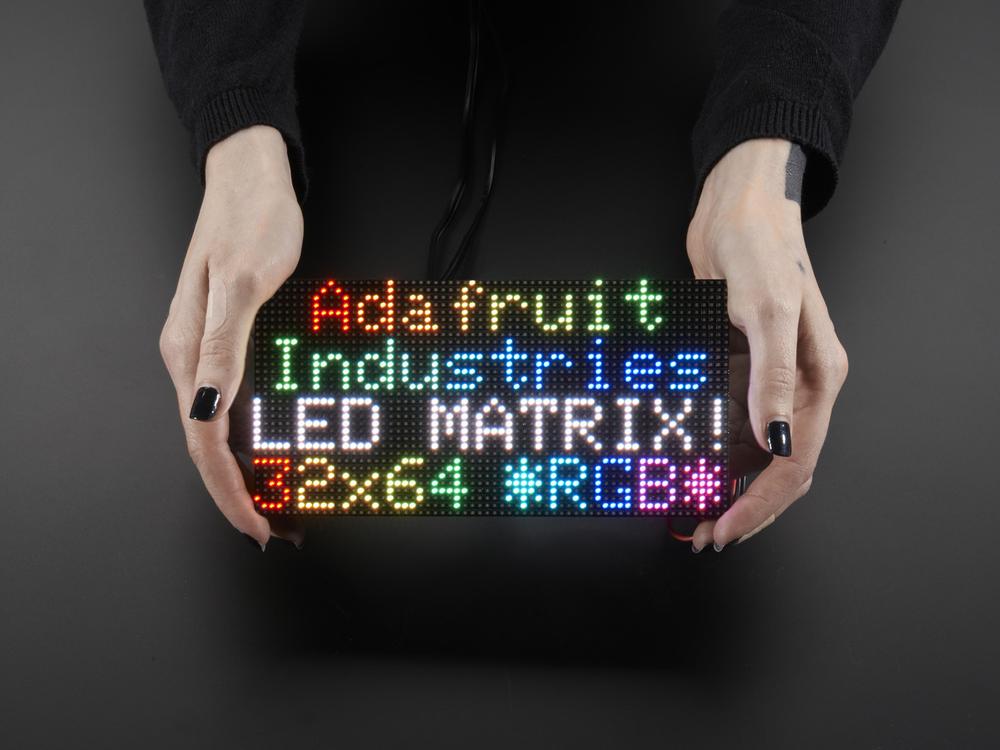Adafruit 64x32 RGB LED Matrix - 3mm pitch

Description
Bring the vibrant spirit of Times Square to your living space with a 64x32 RGB LED matrix panel. Ideal for crafting video walls, these panels embellish spaces with animations and short video clips.
This 3mm pitch version offers closer LEDs for crisp indoor viewing, even from a wide 160-degree angle. Perfect for ambient light settings, this panel showcases 2048 radiant RGB LEDs on a compact grid.
Equipped with two IDC connectors for chaining and 12 latches for seamless display control, it requires 13 digital pins and a steady 5V power supply, drawing up to 4A per panel.
Designed for high-speed processors, such as SAMD21, SAMD51, or ESP32, this panel needs around 1600 bytes of RAM for optimal performance. Enjoy uniformed, pre-white balanced displays, free from tinted whites.
Secure a ready-to-go board for smooth integration, like the Matrix Portal ESP32-S3, or use our RGB Matrix Bonnet for Raspberry Pi. Explore our tutorials to simplify setup and enjoy this technological marvel at its peak potential.
Properties
| Brand | Adafruit |
| Model | 2279 |
Delivered in 10 to 30 days
Alternative products
- Adafruit 64x32 RGB LED Matrix - 4mm pitch € 49,75 View product
- Pimoroni Ubercorn - Large RGB Pixel Matrix - PIM406 € 62,80 View product
- Adafruit Medium 16x32 RGB LED matrix panel - 6mm Pitch € 43,50 View product
- Adafruit NeoPixel NeoMatrix 8x8 - 64 RGB LED Pixel Matrix € 43,50 View product
- Adafruit 32x32 RGB LED Matrix Panel - 4mm Pitch € 37,25 View product
Related products
Customer questions
Customer Reviews
- In stock Adafruit White LED Backlight Module - Medium 23mm x 75mm € 3,25 View product
- In stock Adafruit NOOds - Flexible LED Filament - 3V 300mm long - Red € 9,50 View product
- 3 pieces In stock Adafruit LED Filament - 3V 26mm long - Warm White 3 Pack € 5,75 View product
- In stock Adafruit I2S 3W Class D Amplifier Breakout - MAX98357A € 7,50 View product
- In stock Adafruit IR Break Beam Sensors with Premium Wire Header Ends - 3mm LEDs € 3,75 View product
- In stock Adafruit Mono 2.5W Class D Audio Amplifier - PAM8302 € 5,- View product
- In stock Adafruit NOOds - Flexible LED Filament - 3V 300mm long - Blue € 9,50 View product
- In stock Adafruit IR Break Beam Sensor with Premium Wire Header Ends - 5mm LEDs € 7,50 View product
- In stock Adafruit Woven Conductive Fabric - 20cm square € 6,25 View product
- In stock Adafruit Mini Metal Speaker w/ Wires - 8 ohm 0.5W € 2,50 View product
- In stock Adafruit Electret Microphone Amplifier - MAX4466 with Adjustable Gain € 8,75 View product
- In stock Adafruit Breadboard-friendly 2.1mm DC barrel jack € 1,25 View product
- 5 pieces In stock Adafruit NeoPixel Diffused 5mm Through-Hole LED - 5 Pack € 6,25 View product
- In stock Adafruit Stereo Enclosed Speaker Set - 3W 4 Ohm € 9,50 View product
- In stock Adafruit NOOds - Flexible LED Filament - 3V 300mm long - Lime Green € 8,75 View product










